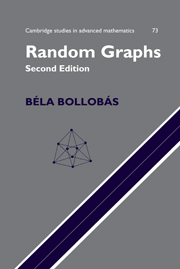Book contents
- Frontmatter
- Contents
- Preface to the Second Edition
- Preface
- Notation
- 1 Probability Theoretic Preliminaries
- 2 Models of Random Graphs
- 3 The Degree Sequence
- 4 Small Subgraphs
- 5 The Evolution of Random Graphs—Sparse Components
- 6 The Evolution of Random Graphs—the Giant Component
- 7 Connectivity and Matchings
- 8 Long Paths and Cycles
- 9 The Automorphism Group
- 10 The Diameter
- 11 Cliques, Independent Sets and Colouring
- 12 Ramsey Theory
- 13 Explicit Constructions
- 14 Sequences, Matrices and Permutations
- 15 Sorting Algorithms
- 16 Random Graphs of Small Order
- References
- Index
1 - Probability Theoretic Preliminaries
Published online by Cambridge University Press: 29 March 2011
- Frontmatter
- Contents
- Preface to the Second Edition
- Preface
- Notation
- 1 Probability Theoretic Preliminaries
- 2 Models of Random Graphs
- 3 The Degree Sequence
- 4 Small Subgraphs
- 5 The Evolution of Random Graphs—Sparse Components
- 6 The Evolution of Random Graphs—the Giant Component
- 7 Connectivity and Matchings
- 8 Long Paths and Cycles
- 9 The Automorphism Group
- 10 The Diameter
- 11 Cliques, Independent Sets and Colouring
- 12 Ramsey Theory
- 13 Explicit Constructions
- 14 Sequences, Matrices and Permutations
- 15 Sorting Algorithms
- 16 Random Graphs of Small Order
- References
- Index
Summary
The aim of this chapter is to present the definitions, formulae and results of probability theory we shall need in the main body of the book. Although we assume that the reader has had only a rather limited experience with probability theory and, if somewhat vaguely, we do define almost everything, this chapter is not intended to be a systematic introduction to probability theory. The main purpose is to identify the facts we shall rely on, so only the most important—and perhaps not too easily accessible—results will be proved. Since the book is primarily for mathematicians interested in graph theory, combinatorics and computing, some of the results will not be presented in full generality. It is inevitable that for the reader who is familiar with probability theory this introduction contains too many basic definitions and familiar facts, while the reader who has not studied probability before will find the chapter rather difficult.
There are many excellent introductions to probability theory: Feller (1966), Breiman (1968), K. L. Chung (1974) and H. Bauer (1981), to name only four. The interested reader is urged to consult one of these texts for a thorough introduction to the subject.
Notation and Basic Facts
A probability space is a triple (Ω, ∑, P), where Ω is a set, ∑ is a σ-field of subsets of Ω, P is a non-negative measure on ∑ and P(Ω) = 1.
Information
- Type
- Chapter
- Information
- Random Graphs , pp. 1 - 33Publisher: Cambridge University PressPrint publication year: 2001
Accessibility standard: Unknown
Why this information is here
This section outlines the accessibility features of this content - including support for screen readers, full keyboard navigation and high-contrast display options. This may not be relevant for you.Accessibility Information
- 1
- Cited by
